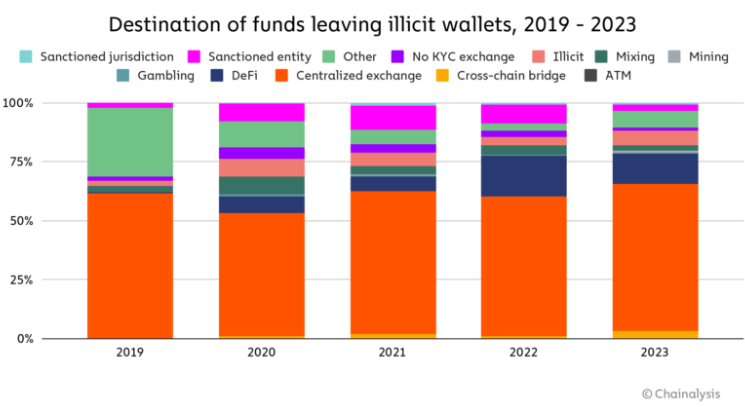Criminals favor centralized crypto exchanges for laundering illicit funds
Total crypto sent to laundering services dropped significantly in 2023, while Lazarus Group shifted to YoMix for laundering.

Share this article
Centralized exchanges continue to be the primary channels for laundering, despite a slight shift in the distribution of illicit funds towards DeFi protocols and gambling services, a Feb. 15 blog post by on-chain security company Chainalysis points out.
However, the use of cross-chain bridges for laundering has surged, particularly among theft-related addresses. The report highlights this as a trend among crypto thieves, facilitating the movement of funds across different blockchains to obscure origins and launder money effectively.
Chainalysis attributes this movement to decentralized finance (DeFi) growth in 2023 while highlighting that DeFi’s inherent transparency generally makes it a poor choice for obfuscating the movement of funds.
The analysis indicates a decrease in the total value of crypto sent to laundering services, dropping from $31.5 billion in 2022 to $22.2 billion last year. This decline surpasses the overall reduction in crypto transactions, highlighting a pronounced decrease in laundering activities.

Moreover, the report reveals a less concentrated pattern of laundering at individual deposit address levels in 2023, despite a slight increase in concentration at the service level. This suggests a possible strategic spread by criminals across more addresses and services to elude detection and enforcement.
The report also highlights the evolving tactics of sophisticated criminal groups, such as the Lazarus Group, which have moved towards utilizing a wider array of crypto services and protocols. Following the takedown of the mixer Sinbad, YoMix emerged as a prominent tool for laundering, with its use by North Korea-affiliated hackers significantly contributing to its growth.
Overall, Chainalysis assesses that money launderers show an adaptive and sophisticated nature in the crypto space, which puts law enforcement agents in a ‘cat and mouse’ game.
